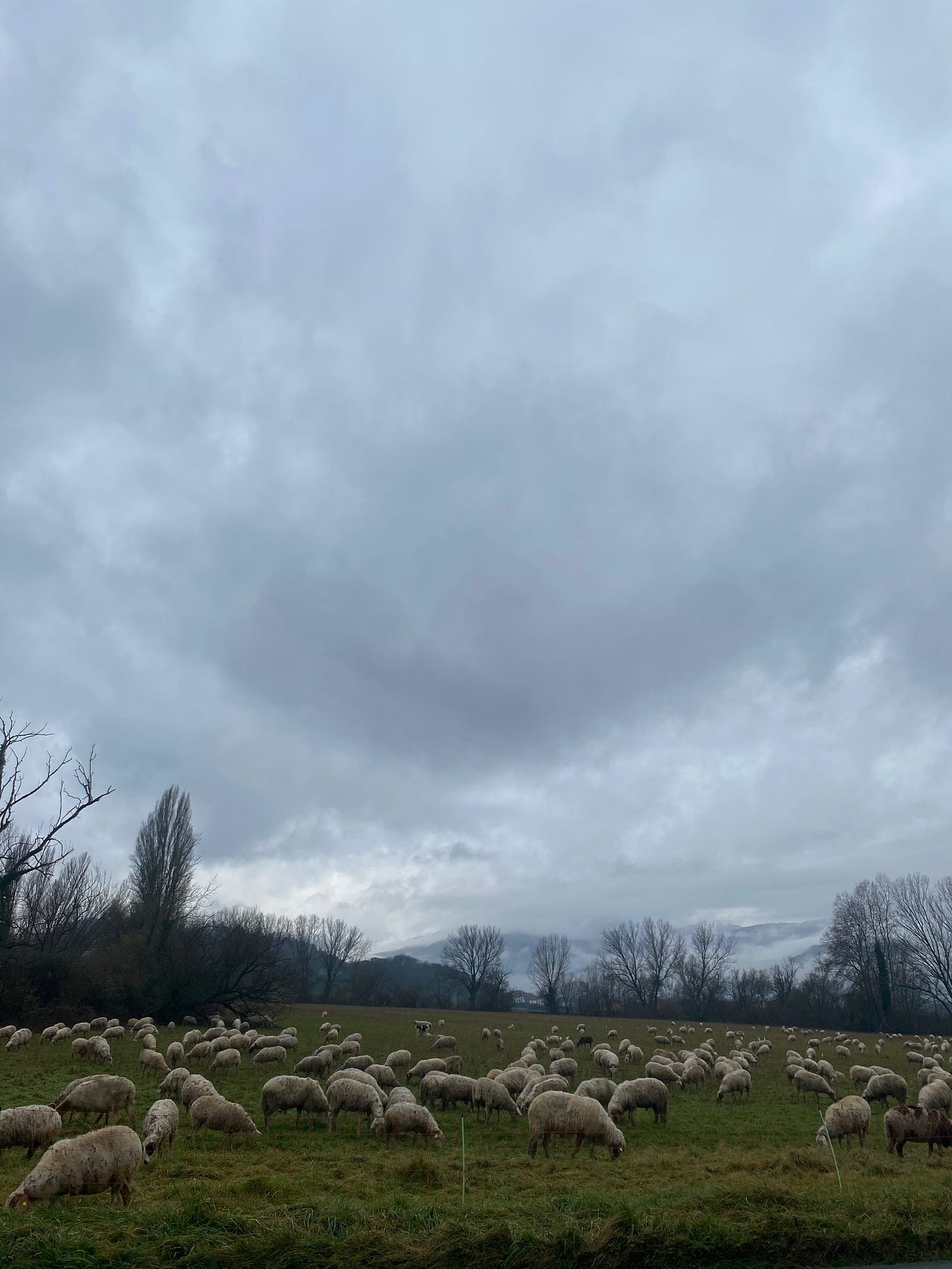
The last few weeks have been cold and rainy here on the Rieti plain, but I don’t mind. The low thin clouds tuck themselves sleepily into the brown hills that surround us, and our world is quiet, slow, sleepy and romantic. Thin streams of smoke are released from every chimney into a steel sky to tell a story of life by the fire. Soon, the locals will wake from their slumber to work the fields and this region’s flora will break through the darkness to face the sun.
The shepherd, who does not rest, goes beyond farmyard stalls to walk the fields and plain in the cold, or under the rain to guide his obedient flock to pasture with his ragged patchwork dogs trailing behind. They are a harmonious group of white specks moving in patterns under ominous snow-capped mountains to transform the current energy and biodiversity of our earth into food.
These are the everyday moving scenes of Italy’s pastoral heritage that spans this land. And what is it?
According to the The UNESCO World Heritage Convention:
Pastoralism is defined as a system of livestock farming which depends, for the most part, on the generally non-intensive use of naturally-occurring plant materials for grazing, either on a farm or as part of a transhumant or nomadic lifestyle. One of the oldest human practices, widespread across the world and involving many types of livestock; pastoralism is intimately connected to the environment and based on a subtle interaction between humans and landscapes. Cultural pastoral landscapes are complex and take many forms. Cultural landscapes embody this interaction between humans and nature.
Through this alchemy by-products of the world’s pastoral heritage are transformed as unique fruits of each territory and moment in time, and from Italy’s nomadic dreams arises the freshest and most gentle ingredient in the Italian kitchen in the form of sheep’s, goat’s, buffalo and cow’s milk ricotta.

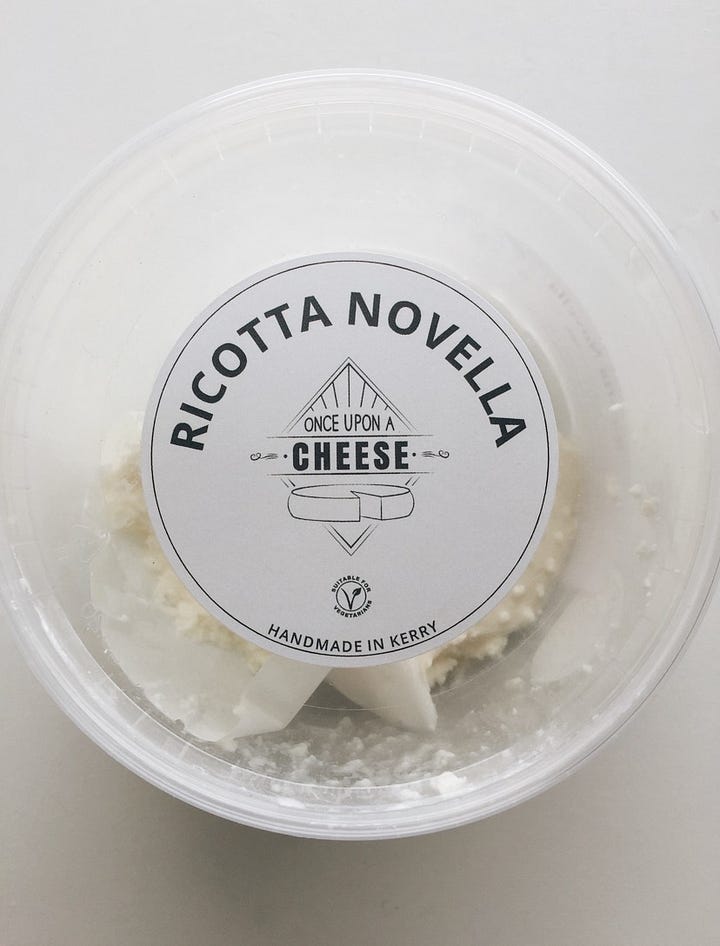
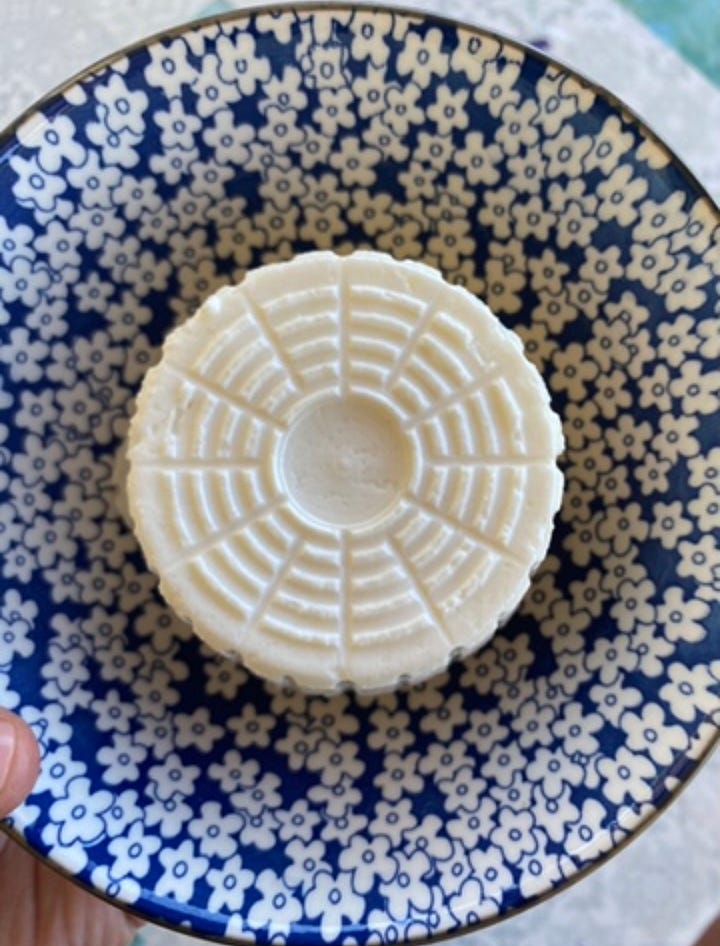
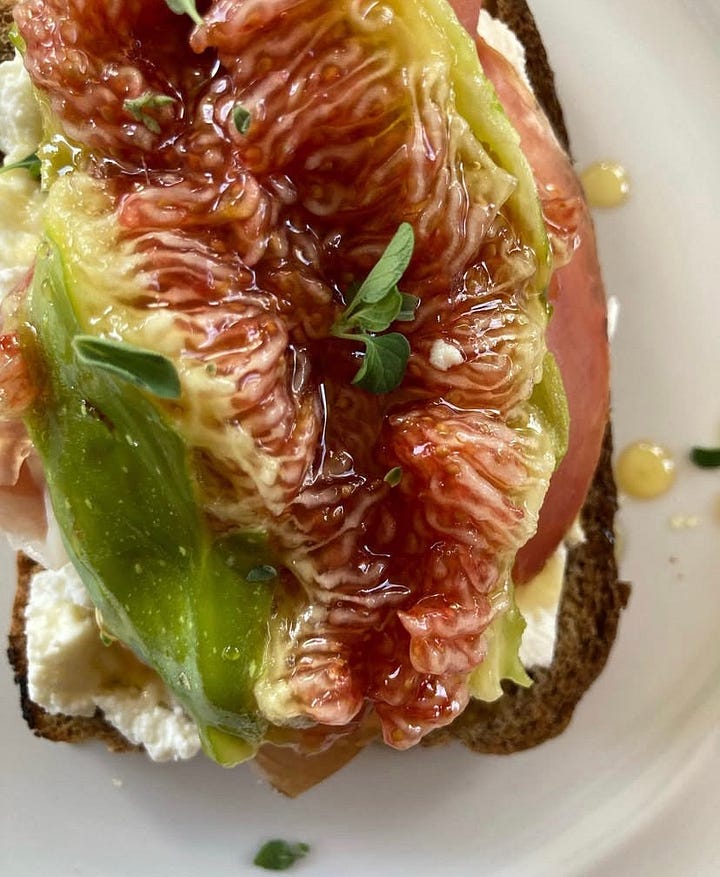
The vast worlds of the unique Italian and Irish pastoral traditions in which I take great interest are to be examined and explored time and time again as solid foundations on which the culinary heritage of these spaces are built.
I do not doubt that women and men in both rural and urban spaces have been consuming fresh ricotta with pasta since its most primitive versions arrived to Italian shores. As a two-ingredient dish in its most simplest form, it provides a quick, hearty, nutritious and satisfying meal whereever a boiling pot of water might be found.
Ricotta in its fresh and aged form is considered a formaggio magro or light cheese (even if it is not actually cheese!). It is both light yet comforting and it is what I am craving and eating right now. This is when ricotta begins to reach its height gaining momentum through the spring as it releases its best properties and aromas to reflect the green energy of mother nature pairing so well with the ingredients that she brings forward in the rebirth of all that is fresh and new. Ricotta is an excellent source of protein and fount of essential vitamins and minerals including calcium and B12:
First of all, when we talk about ricotta, the category used is “dairy product” because during the processing, the curd of the milk is not used, but a simple “re-cooking” of the whey. Woe betide anyone who calls it a “by-product”, however: rather, ricotta is a 'side effect' of the processing of milk to make cheese. When the whey (mainly sheep's) is drained from the curd, it is kept aside and heated: as if by magic, the whey cooked for a second time – hence the name – brings forth light, white flakes, a sublime, soft and fragrant cloud. There are ricottas obtained from cow's milk, with a more delicate flavour than sheep's milk, but they can also be produced from goat's milk or even buffalo milk, as well as from a mix of different types of milk.
A dairy product with an ancient history, traces of which can be found in the Sumerian and Egyptian civilizations: Homer also talks about it in the Odyssey, Book Nine, in which the Cyclops Polyphemus is described as busy processing “white” and “curdled” milk, shortly before seeing Ulysses. The Egyptians seem to have given ricotta its typical round shape, as they sold it to Greek sailors to help them face their first days on board ships with a fresh food: in turn, the Greeks imported and perfected the recipe, which was later adopted by the Romans.
- Gambero Rosso
And yes, ricotta which means ‘re-cooked’ is extremely satisfying nestling like the clouds of these days into Italy’s kitchenscapes. It forms the base of desserts and pastries, lines the insides of fresh egg pasta and savoury tarts, is placed gently on top of charred oven-cooked pizza, balances plates of pasta al pomodoro on a hot summer’s day and is enjoyed in its natural form as part of a fresh breakfast spread or tagliere full of typical local preserves and salumi.
While contemplating ricotta, I was reminded that we can look at things all of our lives without truly seeing them.
As we watch metal spatulas slide into the snowy mountains of ricotta that sit in good company behind the deli counter or peel back the thin plastic film of the basketed containers to make our favourite recipes, do we consider the source of this product, this culmination of energy and time in the intertwined relationship between earth and man?
In these moments of shopping, cooking and eating, where we are often so very disconnected from the source, we might stop to consider the shepherd. We might think about the story of their lives and their joys and troubles as they walk these ancient paths that are carved into our modern world.
When we moved to Calabria many years ago, it was Domenico who made me consider the shepherd when he would deliver the freshest ricottine or mini forms of sheep’s milk ricotta to the front gates of Donna Mimma’s noble fortress and then later to our own front door. This ricotta, which might be served on silver trays in heaven, was too delectable to be transformed into anything and so they were consumed so very slowly with the tip of a silver spoon.
The other day while I was driving home past those long low clouds spreading under the misty rain, I passed a soggy green field close to the road unexpectedly filled with sheep. I immediately reversed the car and stopped to admire the said dance between animal and man and to listen to the music that echoed from the sounds of their bells.
I signaled to the shepherd to ask if I could take some footage of that beautiful moment and he gave me a nod. When I was finished I took another few minutes to drink in the scene. Before I drove away I shouted ‘Grazie!’, as I often do when I stop to admire animals and their owners going about their business in the countryside.
It’s a thank you for their contribution to humanity, for the lives that they give to produce the food that we will eat today and for those quiet moments at dawn where they sit alone to prepare the ricotta that we whip with our forks in order to create the recipes that sit like jewels in Italy’s culinary crown.
Although pasta and ricotta is enjoyed all over Italy adhering to variations on simple local recipes and methods, today it is recognized as a traditional dish of Lazio and our local cucina Sabina which stretches beyond these everchanging geopolitical borders.
I prefer to enjoy pasta and ricotta, essentially a 2-3 ingredient recipe, as it is prepared locally and as detailed below. I also make it with ditalini as they do in Sicily. The use of this small pasta corta appeals to children and it is a quick comfort food that also makes me feel like a kid again
Considering the shepherd, I will leave you with this quote which I wrote down after watching an episode of Chef’s Table on Netflix while rocking a small child to sleep in the dark nearly 10 years ago.
These words live among the scribbled pages of my notebooks as the inspiration for everything that I dream to do. They still move me to tears as they did on that night and I would like to share them with you… I hope that you are also moved to consider the shepherd and all of people who work with love everyday to provide us with our food.
“I have deep roots here in Sicily, my land where I live and work, the clear air, the blue sky, the strong yellow of the wild dried herbs, the light, the sounds, the colours…. A spectacular landscape that produces the best ingredients in the world. It inspires me to create from nature, to understand what is good, and can be transformed into food. This is how to build a recipe. I want to protect and share our culture, to honour our traditions. In every expression of our work, bringing to the world a perspective that belongs to this land.
On La Pecora Nera dairy farm in Noto:
To make pastries, you don’t need industry. When purchasing raw materials, I go directly to the farmers of our land. There is no quality in the ingredient, if there is no quality in the person that produces it. So, you need to find farmers who understand quality in their work. Franzo our great shepherd and ricotta producer works from 2:30am to midnight hand milking over 500 animals to make the ricotta perfect. Franzo is a person of quality, extremely serious and rigorous. But the public doesn’t know anything about his work and that is a huge regret for me; I want him to succeed in giving a future to his family and his farm. So, I made my friends appreciate Franzo’s products – cooks, pizza makers, pastry chefs, and now they buy his cheeses. He always thanks me for what I am doing for him, but it is me who should constantly thank him. The gelato I make with ricotta flavoured with rum and chopped pistachios would be impossible without Franzo’s work. It is my duty, if he gives me his perfect ricotta, to make the perfect gelato.” - Corrado Assenza, Fourth Generation co-owner and pastry chef at Caffe Sicilia in Noto, Sicily
Pasta and ricotta can be made with ricotta that is made from the milk of sheep, cow, buffalo or goat with cow’s milk ricotta being the most palatable. I encourage you to use the freshest ricotta that you can find for this dish. Alternatively, seek out a high quality Italian brand. Ricotta is not lactose-free, but sheep’s and goat’s milk ricotta is easier to digest than the ricotta that comes from buffalo and cow’s milk. Personally I use the lactose-free version of a high quality Italian brand. Spaghetti, rigatoni, mezze maniche, tortiglioni, ditalini as well as fresh egg tagliatelle and fettuccine work here. Round our your meal with a seasonal salad or a plate of cooked greens.
Pasta and Ricotta
Pasta con la ricotta
GF + LF + VE
Serves 1
Ingredients:
80-100g of wholegrain pasta, regular or gluten-free
60g high quality ricotta, regular or lactose-free
10g of finely grated Parmigiano Reggiano and/or Pecorino Romano
Sea salt + freshly ground black pepper
Method:
Bring a medium pot of water to a boil. Add a small handful of salt and return to the boil.
Add your pasta and gently stir to separate.
Add the ricotta to your serving bowl and warm it over the boiling water for a minute or two.
Remove the bowl from the top of the pot, gently whip the ricotta with a fork, add a tablespoon or two of cooking water, stir it again and then add 5 grams of the cheese and black pepper.
Drain the pasta when al dente reserving a bit of cooking water. Add the pasta directly to the serving bowl and gently toss adding a few splashes of cooking water to loosen it if necessary.
Garnish with the rest of the cheese and another twist of black pepper if desired.
Notes:
For more than 1 serving you can prepare the ricotta cream in a larger gently warmed serving bowl or frying pan (stirring with a wooden spoon) that is large enough to accomodate the tossing of the pasta.
Feel free to adjust the amount of ricotta to your liking. It’s a personal thing.
To shake it up a little I sometimes garnish this dish with:
1. A small squeeze of fresh lemon and/or some zest
2. Lightly toasted walnuts finely chopped
All versions will benefit from some fresh marjoram if you fancy.





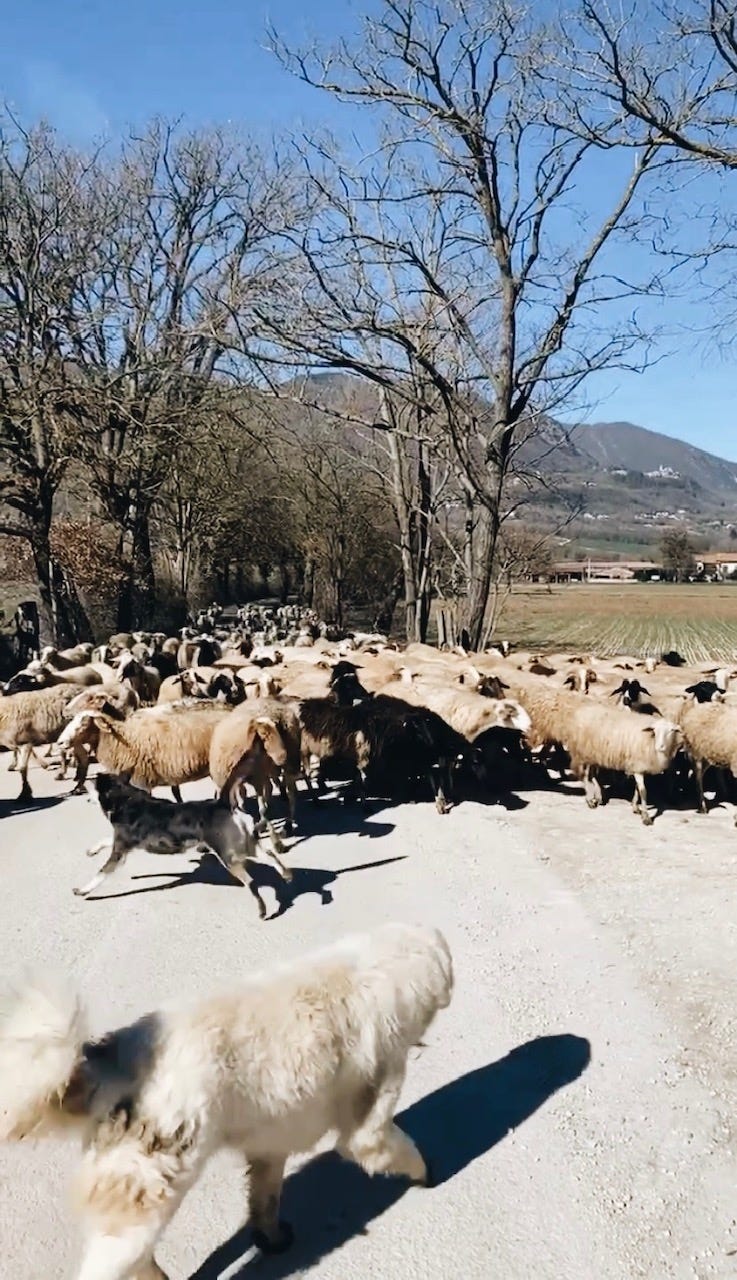
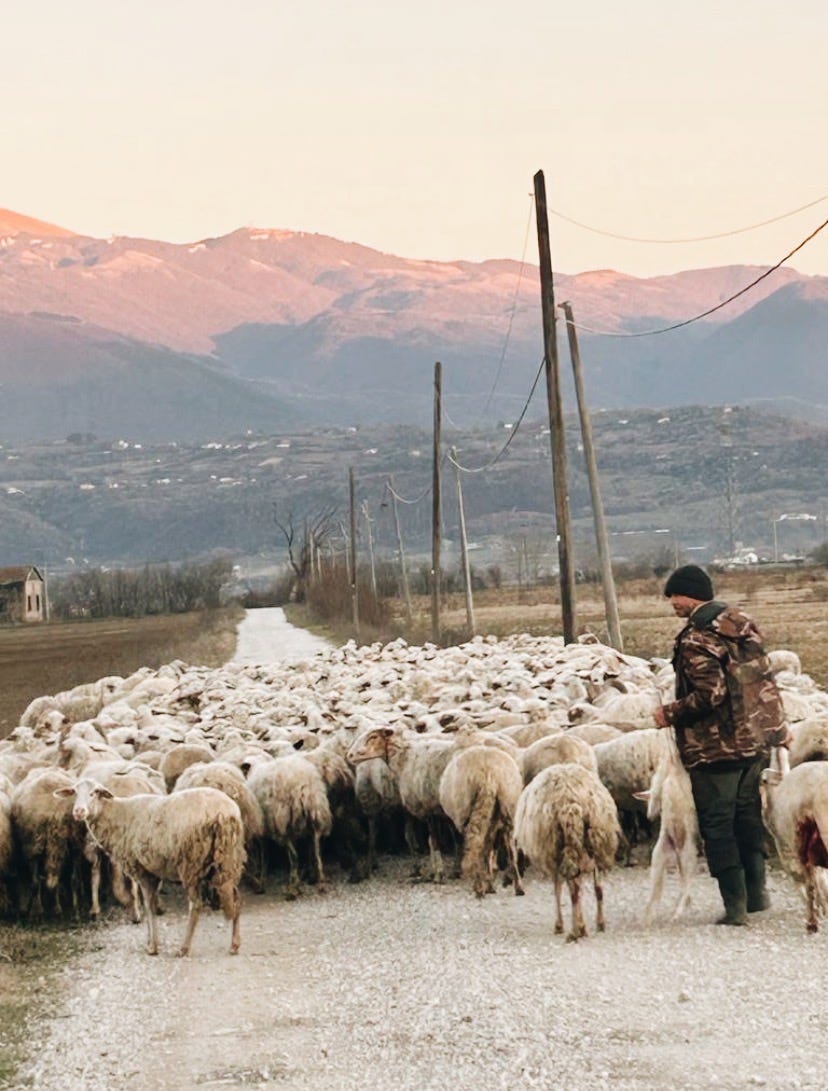
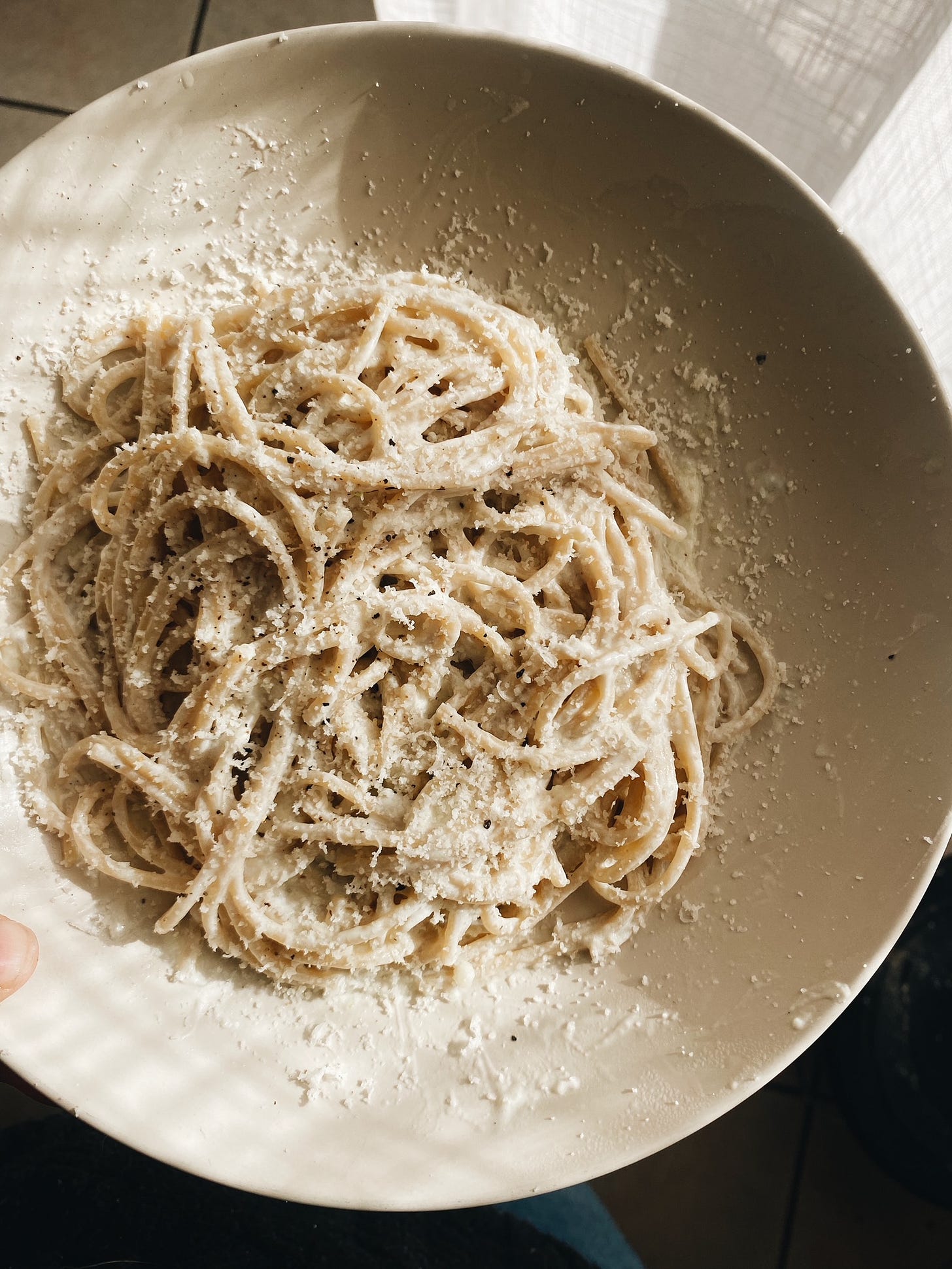

Yum! This was the first recipe I posted on Weeknight Pasta from Italy and is a staple in our house! Such simple bliss.
One of my favorite treats is stuffing (Palestinian grown) dates with ricotta